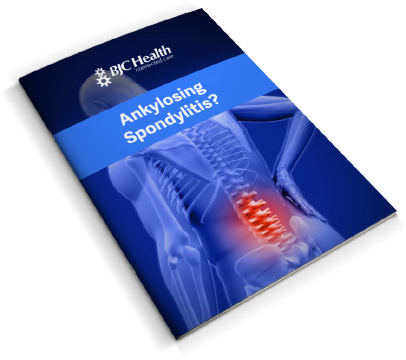What is Ankylosing Spondylitis?
Ankylosing Spondylitis - Pain, Symptoms, Treatments, Causes
Ankylosing Spondylitis (AS) is an inflammatory rheumatic condition that is one of a number of diseases that are characterised by inflammation of the spine termed Spondyloarthritis. The inflammation that occurs particularly affects the sites at which tendons or ligaments join onto bone. The most commonly affected region is the sacroiliac joints, which is where the spine joins onto the pelvis. However, any joint can be affected and, in addition, sites where tendons join onto bone are also commonly involved, such as the insertion of the Achilles tendon into the calcaneus (heel bone). Furthermore, inflammation can occur at other organs in addition to the musculoskeletal system, such as at the eye, intestines, and lungs.
Ankylosing Spondylitis afflicts a small proportion of the population, estimated at about 0.5%, but is commonly under recognized in those suffering with back pain. Consequently, the average time to diagnosis can be quite long, which some have estimated to be as long as 5-7 years. The ability to diagnose this condition early continues to be a significant challenge despite the fact that the disease has been present in humans for thousands of years, as shown in the remains of three Egyptian pharaohs, and the first specific description of the disease being published in 1693. Therefore, a current focus in Ankylosing Spondylitis is how to identify those suffering with the condition at an earlier point in their disease course, at which time the condition is termed axial Spondyloarthitis.
Spondyloarthritis encompasses a group of conditions that share the common clinical manifestation of inflammatory back pain. These conditions include Ankylosing Spondylitis, Reactive Arthritis, Psoriatic Arthritis, and Enteropathic-associated arthritis. There are differences between these conditions that may not be evident early in the disease and only become apparent overtime. However, the emphasis in this early phase of the condition is to determine the presence of an inflammatory spinal disease, rather than differentiating between these specific conditions.
Ankylosing Spondylitis is the most common of the Spondyloarthritides. The condition is symptomatically more common in men, with the usual age of onset being in the 3rd and 4thdecades of life (average age at onset is 26 years). It is unusual for the disease to commence after the age of 50. Overall, Ankylosing Spondylitis is more common in the Caucasian population. There is a familial predisposition to the disease, whereby the risk of developing AS is increased if a first degree relative is affected, especially if HLA B27 (a genetically determined cellular marker) is present.
The consequence of the inflammation present within the spine and other musculoskeletal structures is subsequent uncontrolled increase in bone formation that results in stiffening and ultimately fusion of the joints. It is this process that gives the condition its name of Ankylos – Greek (Gr) for stiffening; Spondylos – vertebra (Gr); itis – inflammation (Gr). The fusion that occurs in the spine commonly causes the affected to have a stooped (flexed hip) posture, that ultimately has a significant impact upon their ability to look forward and walk.
What is Ankylosing Spondylitis?
Download this eBook on this inflammatory rheumatic condition
Understand the causes, the signs and symptoms, how it's diagnosed and most importantly how it's treated.
Download Now
Get the help you deserve - talk to our friendly team today! 1300 252 698
Our Latest Articles
Like most rheumatologists, the doctors at BJC ....
Ketosis, bulletproof coffees, keto flu, fat ....
Now one thing I have found as an Exercise ....
-
What is chair yoga and is it for me?
By
Rhianne Kerr on June 8, 2020
Now one thing I have found as an Exercise Physiologist and Yoga Teacher, is that a traditional yoga practice is not necessarily for everyone. It can ...
BJC Health and Fitness -
Struggling with fatigue?
By
 Sarah Comensoli
on May 19, 2020
Sarah Comensoli
on May 19, 2020
We've had a number of clients reach out to us in the last few weeks expressing that it's more difficult at the moment to get a good handle on their ...
BJC Health and Fitness -
Restricting medical care to traditional in-clinic consultation is so 20th century!
By
 Dr Irwin Lim
on May 17, 2020
Dr Irwin Lim
on May 17, 2020
Like most rheumatologists, the doctors at BJC Health have fixed session times at various clinics where we consult. We typically start at 0800 and end ...
BJC Connected Care -
Feeling more aches and pains?
By
 Sarah Comensoli
on May 10, 2020
Sarah Comensoli
on May 10, 2020
We totally appreciate at the moment that some of our clients are experiencing more aches and pains than they’re usually accustomed to, and we get it. ...
BJC Health and Fitness -
How our Rheumatology service might look after 6 months of the Covid-19 pandemic
By
 Dr Irwin Lim
on April 20, 2020
Dr Irwin Lim
on April 20, 2020
On the 5th March, our team of BJC Health leaders met in my living room to discuss our plans for the next 10 years. The planning phase had commenced 4 ...
BJC Connected Care -
Emergency Rheumatology Service for those who can't attend hospital clinics during COVID-19 pandemic
By
 Dr Irwin Lim
on April 14, 2020
Dr Irwin Lim
on April 14, 2020
Thank you for the kind words and support you’ve provided BJC Health on social media. Our multidisciplinary team is working hard to engage and develop ...
BJC Connected Care -
How Covid-19 sped up Rheumatology Telehealth delivery
By
 Dr Irwin Lim
on April 7, 2020
Dr Irwin Lim
on April 7, 2020
It’s been a really challenging time for us at BJC Health as I am sure it has been for all of you. If one good thing has come out of the COVID-19 ...
BJC Connected Care -
Asked to see a Physio for a Metrology Assessment? Here's what to expect.
By
Dominic Fitzgerald on March 11, 2020
If you have recently been diagnosed with Ankylosing Spondylitis (AS) or a Spondyloarthropathy (SpA), some Rheumatologists might look to refer you to ...
BJC Health and Fitness -
Living with a chronic disease is like living in a cell
By
 Sarah Comensoli
on March 1, 2020
Sarah Comensoli
on March 1, 2020
Those words came directly from a client who has recently started working with our allied health team here at the clinic. No-one has ever explained ...
BJC Health and Fitness -
Chewing the fat. Is the keto diet the way to go?
By
Stephanie Hage on January 27, 2020
Ketosis, bulletproof coffees, keto flu, fat bombs… all buzzwords that you might hear related to the ketogenic (keto) diet. But what exactly is the ...
BJC Diet and Nutrition -
Game changers: is a plant-based diet the key to good health?
By
Stephanie Hage on December 19, 2019
Game Changers - it’s the documentary that everyone is talking about. It seems as though one day I woke up, opened my Instagram account and found ...
BJC Diet and Nutrition -
The Portfolio Diet...Does it help with inflammation?
By
Stephanie Hage on October 23, 2019
As a dietitian, the word “diet” is probably my least favourite word. I appreciate that for many, this single word can bring up past memories of ...
BJC Diet and Nutrition -
Diet Mythbusters!
By
Stephanie Hage on September 19, 2019
The internet can be both your best friend and worst enemy when it comes to finding information about food. If you have a rheumatic disease such as ...
BJC Diet and Nutrition -
Are you realllyy eating well?
By
Stephanie Hage on August 23, 2019
What does eating well mean to you? It could be: Keeping your blood test results in check Eating adequate serves of food from each of the food groups ...
BJC Diet and Nutrition -
Introducing Rheumatology Republic - Join our community!
By
 Dr Irwin Lim
on March 5, 2019
Dr Irwin Lim
on March 5, 2019
I’m sorry that I’ve been missing from this blog. I was galvanized to start blogging in late 2010 to try and rectify community attitudes to ...
BJC Connected Care
BJC Parramatta
Level 1, 17-21 Hunter Street,
Parramatta NSW 2150
Tel: +61 2 9890 7633
Fax: 02 98907655
BJC Chatswood
Ground floor, 7 Help Street,
Chatswood NSW 2067
Tel: +61 2 9413 2979
Fax: 02 9413 3316
BJC Bondi Junction
Suite 105, Level 1, 332-342 Oxford Street,
Bondi Junction NSW 2022
Tel: +61 2 9055 1790
Fax: 02 9169 3497

